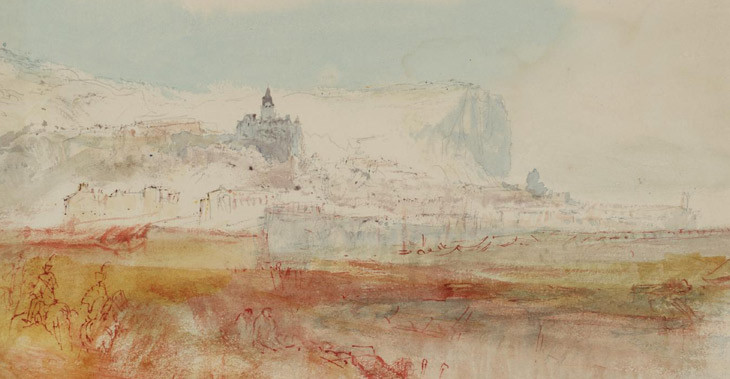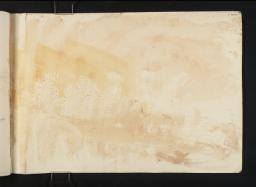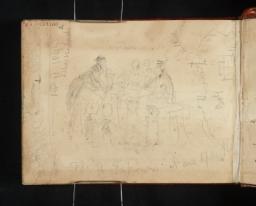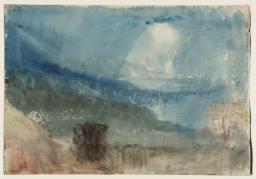Autumn Tour of Northern France 1845

From the entry
In September 1845, Turner embarked on what was to be his final Continental tour: a brief visit to the towns of Dieppe, Eu, and Le Tréport on the coast of Normandy, northern France. At least three sketchbooks accompanied the artist on this final Channel crossing. These included Eu and Tréport and Dieppe (Turner Bequest CCCLIX, CCCLX), two soft-covered ‘roll sketchbooks’, and the smaller Dieppe and Kent book of pencil studies, which was in more general usage around this date (Tate; Turner Bequest CCCLXI). David Blayney Brown has described this trip as a consolation for the annual Swiss tour which Turner had been forced to cancel owing to ill health and the burdensome duties of Deputy President of the Royal Academy. Certainly, at only eleven hours from London by train and steam packet, the harbour and holiday resort of Dieppe was a quick and convenient destination for an ailing septuagenarian artist with little time to spare. At the same time however, multiple sketches from previous journeys ...
Dieppe and Kent Sketchbook 1845
D35487–D35510, D35512, D35514–D35527, D35529–D35552, D35554–D35555, D35557–D35565, D35567–D35595, D35597–D35605, D35607–D35615, D35617–D35642, D35644–D35684, D41150–D41151
Turner Bequest CCCLXI 1–108a
D35487–D35510, D35512, D35514–D35527, D35529–D35552, D35554–D35555, D35557–D35565, D35567–D35595, D35597–D35605, D35607–D35615, D35617–D35642, D35644–D35684, D41150–D41151
Turner Bequest CCCLXI 1–108a
In September 1845, Turner embarked on what was to be his final Continental tour: a brief visit to the towns of Dieppe, Eu, and Le Tréport on the coast of Normandy, northern France. At least three sketchbooks accompanied the artist on this final Channel crossing. These included Eu and Tréport and Dieppe (Turner Bequest CCCLIX, CCCLX), two soft-covered ‘roll sketchbooks’, and the smaller Dieppe and Kent book of pencil studies, which was in more general usage around this date (Tate; Turner Bequest CCCLXI).
David Blayney Brown has described this trip as a consolation for the annual Swiss tour which Turner had been forced to cancel owing to ill health and the burdensome duties of Deputy President of the Royal Academy.1 Certainly, at only eleven hours from London by train and steam packet, the harbour and holiday resort of Dieppe was a quick and convenient destination for an ailing septuagenarian artist with little time to spare.2 At the same time however, multiple sketches from previous journeys through this region and at least one major canvas reveal the high regard in which Turner held this picturesque stretch of upper Normandy as a fruitful source of ideas. In the Turner Bequest, these sketches include pages from the Dieppe, Rouen and Paris and Paris, Seine and Dieppe sketchbooks from the 1820s, for example Tate D24510 and D18557 (Turner Bequest CCLVIII 6, CCXI 21), and loose sheets such as Tate D24955 and D24956 (Turner Bequest CCLX 119, 120). In 1825, the painter had exhibited Harbour of Dieppe (Changement de Domicile), now in the Frick Collection, New York, in which the industrious northern shipping town is depicted as an orderly classical vision, bathed in warm quasi-Mediterranean sunshine.3 Ian Warrell observes that Turner had first noticed the artistic potential of Eu when travelling from Abbeville to Dieppe in 1834.4
The content of the Eu and Tréport and Dieppe sketchbooks bears close comparison with the ‘roll sketchbooks’ that Turner used on his restorative trip to Picardy in the spring of the same year. Just as the artist had travelled around the outskirts of Boulogne capturing its ancient citadel from various vantage points (Tate D35417, D35424, D35425, D35427, D35430, D35431, D35433; Turner Bequest CCCLVIII 15, 18v–19, 20, 21v, 22, 23), these new sketchbooks are dominated by contrasting views of the architectural eminences at Dieppe, Eu, and Le Tréport. For sketches of the turreted cliff-top castle at Dieppe, see D35465–D35467, D35477 (Turner Bequest CCCLX 7–9, 19); for the seaside Church of Saint-Jacques du Tréport, see D35438, D35447, D35452, D35458 (Turner Bequest CCCLIX 3, 12, 17, 23); and for the Gothic collegiate church at Eu, see D35437, D35439, D35441, D35448, D35450, D35451 (Turner Bequest; CCCLIX 2, 4, 6, 13, 15, 16). These subjects are also recorded in pencil in the Dieppe and Kent sketchbook, as noted in its introduction. Turner’s life-long interest in the effects of coastal meteorology is also in evidence here.5 As in the earlier Ambleteuse and Wimereux sketchbook (Tate D35386–D35401, D40443; Turner Bequest CCCLVII 1–14), several of these Normandy studies pursue the fleeting light and weather conditions to be seen on the beaches of northern France. See for example, D35438, D35456 (Turner Bequest CCCLIX 3, 21) and D35468, D35473, D35474 (Turner Bequest CCCLX 10, 15, 16).
Although Normandy was a tried-and-tested source of artistic ideas for Turner, a more specific impetus may have drawn him to its shores in the autumn of 1845. In early September, Queen Victoria paid her second visit to King Louis-Philippe at the Château d’Eu to consolidate the developing entente cordiale between Britain and France. As recently discussed in detail by Ian Warrell, a passing reference in a letter from John Ruskin to his father indicates that the King of the French had made contact with Turner in the months prior to the trip.6 Certainly, the two men had long held each other in high estimation and Turner had recently worked up a pair of large canvases to commemorate the King’s state visit to England in the previous autumn.7 There is a distinct possibility therefore that Turner had come to this region specifically in search of a promising, regal subject and even that he had been summoned by Louis-Philippe to make something of the occasion.
A significant number of sheets from the two ‘roll sketchbooks’ feature subjects particularly connected with Victoria’s visits to Louis-Philippe. In the Eu and Tréport sketchbook, there are multiple views of the long-fronted Château d’Eu, seen both within the wooded environs of the Bresle valley and at close quarters amidst the architecture of the town; see D35437, D35439, D35441, D35448, D35450, D35451, D40172 (Turner Bequest CCCLIX 2, 4, 6, 13, 15). The same sketchbook depicts from several vantages the spot in Le Tréport harbour where the Queen’s yacht was moored; see D35438, D35447, D35452, D35458 (Turner Bequest CCCLIX 3, 12, 17, 23). In the Dieppe sketchbook, several warm-toned sketches depict palatial interiors, brightly lit with candelabra or tall arched windows; see D35478, D35480, D35482, D35484 (Turner Bequest CCCLX 20–23). Such features are consistent with the state apartments of the Château d’Eu, as detailed in the meticulous watercolours commissioned from Eugène Lami (1800–1890) by Louis-Philippe as a gift for Victoria to commemorate her 1843 visit; see especially, Royal Visit to Louis-Philippe: the Salon de Famille, Château d’Eu 1843 (Royal Collection).8
Stylistically the Eu and Tréport and Dieppe sketchbooks are of a piece, generally deploying a small number watercolour glazes ‘freely washed with a very liquid brush over pencil indications’.9 This was a type of sketch which, as Richard Johns observes, Turner had developed on his sketching tours several decades earlier and probably involved draughtsmanship in the field followed by painted embellishments on a later occasion.10 In addition to the sketches discussed above from the spring 1845 tour of northern France, closely comparable pieces of a similar date can be found in the small Channel sketchbook of about 1845 (Yale Center for British Art, New Haven)11 and in the Ideas of Folkestone ‘roll sketchbook’ of 1845 (Tate; Turner Bequest CCCLVI) in the ‘Kent Coast and Whaling c.1844–5’ section of the present catalogue.
Note: In the course of ongoing cataloguing, the Dieppe and Kent sketchbook (previously omitted owing to its more diverse content) was added to this section in 2016, as reflected in minor amendments to this Introduction.
David Blayney Brown, Turner and the Channel: Themes and Variations c.1845, exhibition catalogue, Tate Gallery, London 1987, p.12.
John Murray (ed.), Hand-Book for Travellers in France, revised ed., London, Paris and Leipzig 1844, p.xli.
Martin Butlin and Evelyn Joll, The Paintings of J.M.W Turner, revised ed., New Haven and London 1984, pp.126–7 no.231, pl.234.
Ian Warrell, Through Switzerland with Turner: Ruskin’s First Selection from the Turner Bequest, exhibition catalogue, Tate Gallery, London 1995, p.40.
For Turner’s abiding interest in the sea, see James Hamilton, Turner: The Late Seascapes, exhibition catalogue, Sterling and Francine Clark Art Institute, Williamstown 2003; also Ian Warrell (ed.), Franklin Kelly and others, J.M.W Turner, exhibition catalogue, National Gallery of Art, Washington 2007, pp.187–201, and Christine Riding and Richard Johns (eds.), Turner and the Sea, exhibition catalogue, National Maritime Museum, London 2013.
Ian Warrell, ‘I saw Louis Philippe land at Portsmouth’: Fixing Turner’s Presence at the Arrival of the King of the French, 8 October 1844’, Turner Society News, no. 120, Autumn 2013, p.9.
Paul André Lemoisne, L’OEuvre d’Eugène Lami (1800–1890) Lithographes-dessins-aquarelles-peintres. Essai d’un catalogue raisonné, Paris 1914, p.119, no.505. For other interior depictions of the Château d’Eu in the 1840s, see also Pierre F.L. Fontaine, Château d’Eu, Paris c.1845.
Christine Riding and Richard Johns (eds.), Turner and the Sea, exhibition catalogue, National Maritime Museum, London 2013, p.203
How to cite
John Chu, ‘Autumn Tour of Northern France 1845’, February 2014, revised by Matthew Imms, September 2016, in David Blayney Brown (ed.), J.M.W. Turner: Sketchbooks, Drawings and Watercolours, Tate Research Publication, April 2015, https://www



